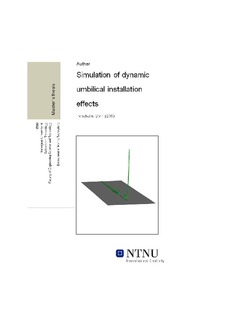| dc.description.abstract | The background for this study is a request from Technip related to the need of installing of long length umbilicals utilizing large capacity vessels designed for installation of steel pipelines. The installation vessel, Apache, operated by Technip, has for this reason been studied.
Two computer programs developed by Marintek, SIMLA and RIFLEX, have been used for this study. A literature study has taken place on the background theories of the programs. They are both based on the finite element method, and they analyze given problems very similarly. Nevertheless, one main difference was found, and that difference is in how they solve the dynamic time domain analyses. RIFLEX uses a Newmark β-method, while SIMLA uses HHT α-method.
A lay scenario and 20 sea states have been defined and modeled in both RIFLEX and SIMLA. The chosen lay scenario is at 360 meters water depth. The seabed is completely flat, thus no free spans will affect the result. All sea states are regular waves with wave propagation run directly against the course of the vessel. The umbilical is a thin and light weight umbilical with a diameter of only 9 cm.
Both static and dynamic analyses have been run for all sea states. Results from all sea states have been thoroughly studied and described. It was found that for this lay scenario, RIFLEX run the analyses more than twice as fast as SIMLA.
The static results are close to being identical for both programs, showing that the modeling must be correct considering the overall arrangement and orientations for the lay scenario, and considering the umbilical data like size, weights and the different stiffness properties.
The dynamic results show that for all results for sea states without compression, the two programs are quite similar. It is shown that RIFLEX also at this stage shows larger values than SIMLA, but the curvature of the plots are very similar. There is a big change of the RIFLEX results for the sea states where there are induced compressions at the touch down point. The compression seems to trigger a variable which makes irrational results for all contact elements of the umbilical and the sea bed. Many peaks can be observed, which is illogical.
SIMLA handles the compression very well, and do still return stable and smooth graphs as a result. As well as the smooth and reliable graphs, the end results from SIMLA are for all sea states smaller than for RIFLEX. This would in a real life project allow installations in heavier sea with use of SIMLA. A run in SIMLA was experienced as a much slower than RIFLEX.
All in all, it has been observed large differences in the dynamic results, especially for the load conditions inducing compression. There is one known modeling error, there might be more, and there is one main difference in the way the programs do dynamic analyses. It is reasonable to believe that the HHT α-method used in SIMLA are the reason for the smoother and more reliable graphs. | nb_NO |
